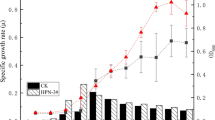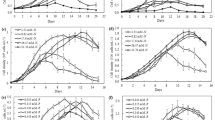Abstract
Microalgae can effectively absorb nitrogen (N) and phosphorus (P) in wastewater, while growth characteristics can be affected by such nutrients. The influences of the N and P concentration on growth, biomass yield, protein yield, and cell ultrastructure of Chlamydomonas reinhardtii (C. reinhardtii) were investigated in this study. The results showed that, in the optimum conditions (24–72 mg/L for N and 4.5–13.5 mg/L for P), the final biomass and protein content of C. reinhardtii could reach maximum value, and the cell organelles (chloroplast, mitochondria,etc.) showed good structures with larger chloroplasts, and more and neater thylakoids. However, if the concentration of nutrients was much higher or lower than the optimal value, it would cause adverse effects on the growth of C. reinhardtii, especially in high nitrogen (1000 mg/L) and low phosphorus (0.5 mg/L) conditions. Under these extreme conditions, the ultrastructure of the cells was also damaged significantly as follows: the majority of the organelles were deformed, the chloroplast membrane became shrunken, and the mitochondria became swollen, even partial disintegrated (differing slightly under high-N and low-P conditions); furthermore, it is found that C. reinhardtii was more sensitive to low-P stress. On the basis of these results, our findings have general implications in the application of wastewater treatment.




Similar content being viewed by others
References
Bradford MM (1976) A rapid and sensitive method for the quantitation of microgram quantities of protein using the principle of protein dye binding. Anal Biochem 6:3177–3188
Chew KW, Yap JY, Show PL, Suan NH, Juan JC, Ling TC, Lee DJ, Chang JS (2017) Microalgae biorefinery: high value products perspectives. Bioresour Technol 229:53–62. https://doi.org/10.1016/j.biortech.2017.01.006
Chisti Y, Yan J (2011) Energy from algae: current status and future trends. Algal biofuels - a status report. Appl Energy 88(10):3277–3279. https://doi.org/10.1016/j.apenergy.2011.04.038
Deng X, Wei B, ZL H (2010) Study on the removal of nitrogen and phosphorus from wastewater by Chlamydomonas reinhardtii. Environ Sci 31:1489–1493
Doğan-Subaşı E, Demirer GN (2016) Anaerobic digestion of microalgal (Chlorella vulgaris) biomass as a source of biogas and biofertilizer. Environ Prog sustain 35(4):936–941. https://doi.org/10.1002/ep.12294
Feng M, Wu Y, Feng S (2008) Effect of different N/P ratios on algal growth. Ecol Environ 17:1759–1763
GB11893-89 (1989) China’s national environmental protection standard “standards for surface water”, Ministry of Environmental Protection of the People’s Republic of China
HJ636-2012 (2012) China’s national environmental protection standard “standards for surface water”, Ministry of Environmental Protection of the People’s Republic of China
Harris E (1989) The Chlamydomonas sourcebook: a comprehensive guide to biology and laboratory use. San Diego, CA
Hurkman WJ, Tanaka CK (1986) Solubilization of plant membrane proteins for analysis by two-dimensional gel electrophoresis. Plant Physiol 81(3):802–806. https://doi.org/10.1104/pp.81.3.802
Levy I, Gantt E (1990) Development of photosynthetic activity in porphyridium purpureum (Rhodophyta) following nitrogen starvation. J Phycol 26(1):62–68. https://doi.org/10.1111/j.0022-3646.1990.00062.x
Li X, Hu HY, Gan K, Sun YX (2010) Effects of different nitrogen and phosphorus concentrations on the growth, nutrient uptake, and lipid accumulation of a freshwater microalga Scenedesmus sp. Bioresour Technol 101:5494–5500
Li Y, Chen YF, Chen P (2011) Characterization of a microalga Chlorella sp. well adapted to highly concentrated municipal wastewater for nutrient removal and biodiesel production. Bioresour Technol 102(8):5138–5144. https://doi.org/10.1016/j.biortech.2011.01.091
Li SC (2003) Effects of low phosphate stress on plant photosynthesis and respiration. J Shihezi University 7:157–160
Mata TM, Martins AA, Caetano NS (2010) Microalgae for biodiesel production and other applications: a review. Renew Sust Energ Rev 14(1):217–232. https://doi.org/10.1016/j.rser.2009.07.020
Nordlander E, Olsson J, Thorin E, Nehrenheim E (2017) Simulation of energy balance and carbon dioxide emission for microalgae introduction in wastewater treatment plants. Algal Res 24(PartA):251–260
Phuong Thu L, Michele B (2016) Carbon and nitrogen removal from glucose-glycine melanoidins solution as a model of distillery wastewater by catalytic wet air oxidation. J Hazard Mater 310:108–116. https://doi.org/10.1016/j.jhazmat.2016.02.024
Prajapati SK, Kaushik P, Malik A, Vijay VK (2013) Phycoremediation and biogas potential of native algal isolates from soil and wastewater. Bioresour Technol 135:232–238. https://doi.org/10.1016/j.biortech.2012.08.069
Redfield AC (1960) The biological control of chemical factors in the environment. Sci Prog 11:150–170
Rasdi NW, Qin JG (2015) Effect of N:P ratio on growth and chemical composition of Nannochloropsis oculata and Tisochrysis lutea. J Appl Phycol 27(6):2221–2230. https://doi.org/10.1007/s10811-014-0495-z
Sarat Chandra T, Deepak RS, Maneesh Kumar M, Mukherji S, Chauhan VS, Sarada R, Mudliar SN (2016) Evaluation of indigenous fresh water microalga Scenedesmus obtusus for feed and fuel applications: effect of carbon dioxide, light and nutrient sources on growth and biochemical characteristics. Bioresour Technol 207:430–439. https://doi.org/10.1016/j.biortech.2016.01.044
Suganya T, Varman M, Masjuki HH, Renganathan S (2016) Macroalgae and microalgae as a potential source for commercial applications along with biofuels production: a biorefinery approach. Renew Sust Energ Rev 55:909–941. https://doi.org/10.1016/j.rser.2015.11.026
Siaut M, Cuiné S, Cagnon C, Fessler B, Mai N, Carrier P, Beyly A (2011) Oil accumulation in the model green alga Chlamydomonas reinhardtii: characterization, variability between common laboratory strains and relationship with starch reserves. BMC Biotechnol 11:1–15
Shi F, Li WJ (2014) Effect of culture models on metabolism and protein components of microalgae Chlorella vulgaris. J. Food Sci Biotechnol 33:56–62
Song LN, Zheng XY, Gu YJ (2010) Effect of P concentrations on chlorophyll fluorescence and growth of Chlorella sp. Environ Pollut Control 32:20–25
Wang M, Yang Y, Chen Z, Chen Y, Wen Y, Chen B (2016) Removal of nutrients from undiluted anaerobically treated piggery wastewater by improved microalgae. Bioresour Technol 222:130–138. https://doi.org/10.1016/j.biortech.2016.09.128
Wang YJ, Gao P, Fan MH (2011) Preliminary study of purification for livestock wastewater of immobilized microcystis Aeryginosa. Procedia Environ Sci 11:1316–1321. https://doi.org/10.1016/j.proenv.2011.12.197
Yu J (2004) Combined effects of enhanced UV-B radiation and enriched CO2 on marine microalgae. Ocean University of China, Qingdao, Shandong, China
Funding
The work was supported by the Chengdu Technology Bureau (2015-HM01-00013-SF), the Nature Science Foundation of Sichuan Province (2017GZ0383), and the Science Foundation of China (31100374), 985 Construction Project.
Author information
Authors and Affiliations
Corresponding author
Additional information
Responsible editor: Guilherme L. Dotto
Rights and permissions
About this article
Cite this article
Wang, Y., Yu, J., Wang, P. et al. Response of energy microalgae Chlamydomonas reinhardtii to nitrogen and phosphorus stress. Environ Sci Pollut Res 25, 5762–5770 (2018). https://doi.org/10.1007/s11356-017-0931-0
Received:
Accepted:
Published:
Issue Date:
DOI: https://doi.org/10.1007/s11356-017-0931-0




